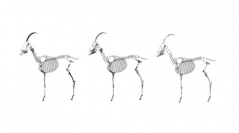

 Comptes Rendus Palevol
16 (3) - Pages 333-350
Comptes Rendus Palevol
16 (3) - Pages 333-350El Harhoura 2 cave (Témara, Morocco) has yielded Aterian and Iberomaurusian lithic artifacts associated with faunal remains. Both humans and carnivores occupied this cave and non-human predator modifications occurred mainly at the end of the Late Pleistocene. Diverse faunal taxa have been identified, with a predominance of gazelles and various carnivores, particularly canids. The location of the cave and of the excavation area, at the bottom of a cliff of low elevation and in the entrance of the cave, does not correspond to a protected area for large raptor nests or a natural trap. Considering the consumed species, the type of carnivore remains, the skeletal representation of prey, taphonomic alterations such as tooth marks, semi-digested bones and destruction sequences, large canids would be the main cause for faunal modifications. However, North African fossil data attributed to hyena activities present similar results. This paper highlights the difficulty of discriminating between potential accumulators/consumers due to a lack of taphonomic reference data. This study thus demonstrates the necessity of compiling fossil records and neotaphonomic reference data for North African medium-large predators in order to better understand the taphonomic history of North African archaeological and paleontological sites.
Taphonomy, Carnivores, North Africa, Late Pleistocene